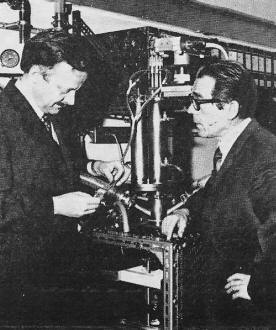|
May 1973 Popular Electronics
 Table of Contents Table of Contents
Wax nostalgic about and learn from the history of early electronics. See articles
from
Popular Electronics,
published October 1954 - April 1985. All copyrights are hereby acknowledged.
|
The
Josephson effect
was predicted in 1962 by British physicist Brian David Josephson. It postulated the possibility
of a resistance-less path for electrical current across an extremely thin insulator sandwiched
between two superconductors.
Dr. Juri Matisoo, of IBM, is credited with building the first Josephson
junction switch in 1967, demonstrating sub-nanosecond switching times. Back in the
day, superconducting materials, like graphene, were resources available only to well-funded
research establishments like major corporations, universities, and government facilities.
Now, anyone with an interest can order both
superconductors and
graphene from Amazon or eBay. Because of their quantum nature, Josephson
junctions are used widely in metrology as base unit standards.
Fastest Electronic Device

Drs. Wilhelm Jutzi (left) and Theodor Mohr, of IBM, check the new
device.

Small bounded oval at center of this photomicrograph is a Josephson
junction, measuring 1.25 by 3 microns. Broad white areas are 50-ohm transmission lines
connecting junction to the external time-measuring circuitry.
In 1962, the English physicist Brian Josephson predicted that an insulator could behave
like a superconductor (complete disappearance of electrical resistance at very low temperatures),
provided it was thin enough and was sandwiched between two layers of superconductive
metals.
Now, in 1973, scientists at the IBM Research Division have used the Josephson effect,
combined with other experimental findings, to indicate that current could pass through
an ultra-thin insulating barrier between superconductors in two different ways, to produce
an electronic switch that can operate in less than 10 trillionths of a second (picoseconds).
In performing this switching action, the device requires only about 1/10,000 the power
of the best switching transistor.
This tiny power consumption means that the junctions generate very little heat and
thus can be packed very closely together. Since an electrical impulse travels about 1
mm in the time that a Josephson junction switches, dense packing is essential to avoid
excessive delay as the signal travels from one circuit to the next.
At low current levels and with no magnetic field present, the current passes (or tunnels)
through the insulator as if it were a superconductor. There is no voltage drop across
the junction. If the current, or an applied magnetic field, is raised above a certain
critical level, conduction through the insulating barrier is by the familiar form of
electron tunneling similar to that found in a tunnel diode. The two differences - the
presence or absence of a voltage drop - represents the 1 or 0 levels of digital computer
logic.
The first Josephson junction switcher was reported in 1967 by Juri Matisoo of IBM,
who measured a switching speed of less than 800 picoseconds. The higher speed is a result
of the decreased size (1.25 by 3.1 microns), higher current density, and the sophisticated
instrumentation developed for measuring such short switching intervals.
Posted February 20, 2018
|











